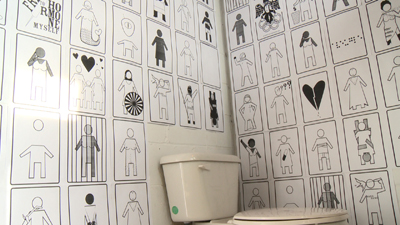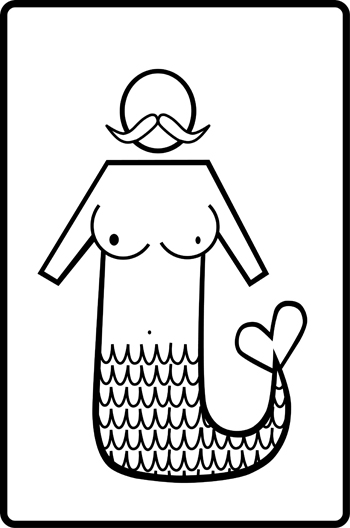Revel & Riot is pleased to announce a new series – interviews with LGBTQ artists! With the new feature we hope to draw attention to the incredible work being done by LGBTQ artists, photographers, filmmakers, writers, designers and creative types worldwide and recognize the profound impact they’ve had on culture and the movement.

ARTIST FEATURE 1: CoCo Riot
by Jenna Meyers
Coco Riot is a Montreal-based queer artist known for self-publishing the Raining Dykes zine series, Gender Poo poster/card/art series, Llueven Queer zine novel, and is the current outreach coordinator for articule Gallery. Identifying as a visual collector of moments, Coco Riot claims invisible spaces and in-between worlds, and aims to create work that builds a strong anti-oppression dialogue. Their illustrations and writing playfully pull at our senses while keeping the viewer engaged with queer politics and personal histories. Coco’s imagery is both accessible and complex, leaving the viewer with thoughts about art and how we categorize identity.
Recently Coco and I sat down to discuss Gender Poo and Llueven Queers. While spilling cookies all over their couch, I listened to them passionately speak about their love of art, community, and what it means to belong.

GENDER POO, LLUEVEN QUEERS AND LANGUAGE
Gender Poo is a series of bathroom signs displaying peoples who are ignored or often seen as invisible in our current society, such as people who have experienced gender oppression. The bathroom installation itself is a meeting point in where many of these issues converge. Begun during university, the project has grown to over 80 different signs. This series has been hung in bathrooms all over the world from museums in New York, spaces in Montreal and all over Europe.
 Currently, Coco Riot has been touring their book Llueven Queers. Working directly with Spanish-speaking communities, the tour is as much of the art as the book. Originally born in Southern Spain, Coco has been presenting collaborative workshops about queer politics around Europe, and will continue to North America. When facilitating these events they ask, “What do you want to talk about? What are the issues of your community?”
Currently, Coco Riot has been touring their book Llueven Queers. Working directly with Spanish-speaking communities, the tour is as much of the art as the book. Originally born in Southern Spain, Coco has been presenting collaborative workshops about queer politics around Europe, and will continue to North America. When facilitating these events they ask, “What do you want to talk about? What are the issues of your community?”
JM: You have identified yourself as a “queer anti-oppression immigration artist”. What does this mean to you?
Coco Riot: Those are three words I use to identify myself. That’s the person who I am everyday. I have an anti-oppression framework, I identify as queer, and I am a migrant person. In a piece of art that I create, I think it is very difficult for all of those to converge in the product, the final piece. How do I do it? In the process of making art I consider many concepts, for example: an anti-oppression framework. How am I going to work with other people? How am I going to create, what are the ideas I am having? My work is based on personal experience. What are those experiences and why am I choosing them. I live 24 hours a day, why am I choosing those exact moments? What do they represent? Then I think about how I am going to promote the piece. You think about the public before creating. Who is going to be interested in this, who am I going to be talking too? What are their interests and how do I want to talk to them? All of these things can determine a queer anti-oppression framework, migrant as well. ( general introduction to anti-oppression)
I began making zines in 2003. I started making zines for the same reasons I make anti-oppression art. I didn’t have zines or comics that could represent me. I’m very interested in multiples. One of the ways I entered the art world was through zines. They can be cheaply reproduced. Anyone can photocopy them. Also, one of my main readings in theory was Walter Benjamin. It had a strong influence on me about breaking art laws. If you do things that can be copied, in a way you are destroying one of the traditional values of art…the masterpiece. It is a way of challenging the art market. I like that people can have art in their houses even if they don’t have money.

JM: In one of your main projects “Gender Poo”, what were some of the questions you were asking?
Coco Riot: The Gender Poo project asks: What does it mean to be normal, to fit, to belong? Is it anyone who belongs and do you really belong to a society? The idea was to show signs that represent people who do not belong. The space and walls are covered with these signs. My other main project is the book, Llueven Queers. It has 80 pages of stories and they are not continuous. People have to create their own narration. In this book I ask, how do we create a culture of belonging?
JM: Within your practice you operate in several different languages. It is a big part of your communication with the viewer. For instance, Llueven Queers is written in one language, the zines in others. Can you talk about navigating art through multiple languages (French, English, Spanish)?
Coco Riot: I feel that I am a lucky person to be able to speak 3 languages. I’m able to be a part of 3 different communities. They have 3 different political sets of activism. In Montreal, for example, I like the idea of belonging to two different communities. However, I belong to a third. The Spanophone community is not as visible in political organizing. That gives me the chance to go from one to the other. These three communities allow me to question, create networks and work together. In my book in Spanish, there are many pages where I kept it in French and English. I want people to know how it feels to be in another language. I want people to feel the transition from one language to another and how that affects the person I am. I am always moving from one language to another. That is a very important part of any migrant person who is not Anglophone or Francophone. We use some language, let’s say English, but inside of us we think in Spanish. The idea of the book is how can we talk about queer politics in another language. For instance neutral pronouns are not yet possible in Spanish. How can we translate terms? How do we create a culture that is respectful of our differences? This is a very important part of the book.
 JM: What are your thoughts on the idea of a queer aesthetic?
JM: What are your thoughts on the idea of a queer aesthetic?
Coco Riot: This is a question I’m considering as an outreach coordinator at articule Gallery. What does it mean! Queer art could be something that talks about having gender and sexual identities that do not belong to the norms. However, that is not what I am looking for. I’m looking for people who engage with the community to create a culture where queer people can identify. Where queer values are valorized. Art that shows different gender identities, different bodies, different abilities, or work that talks about questions we may have. For example, the piece by Coral Short called Platonic Marriages. This was a moment where you could practice queer values: friendship, relationships, and other forms of families. The kind of queer art I like gives value. It gives importance to our community. That is not so much about the oppressions we live, but the things we create.
JM: What seems exciting in what you have talked about is the freedom to shape our own community. There is a total power to shape art and the queer community the way we want it.
Coco Riot: The more we are the better, the more diverse. Our community is not homogeneous. We are very different with a lot of sub-communities. It’s important to show people doing many different things and talking in different languages. Meaning those who use different mediums and tools, so others can identify.